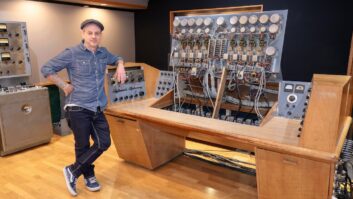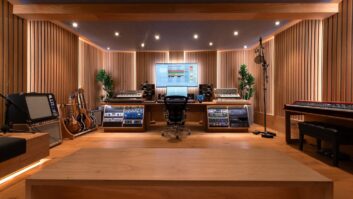
Cindy McSherry, business operations manager; Willie Samuels, engineer, co-manager; Justin Lieberman. chief engineer, co-manager.
Located smack dab in the heart of San Francisco’s ultra-creative and growing SOMA (South of Market) district, on the edge of downtown, Studio Trilogy is exactly the type of recording and production facility that mirrors the city’s changing face as a hub for all sorts of different types of artistic expression. Whereas in the past, some of the “hot” studios in The City have been focused primarily on music recording or commercial production/post work, Studio Trilogy revels in its eclectic approach, offering a one-stop shop for almost any audio project imaginable.
“San Francisco is really vibrant right now,” says chief engineer Justin Lieberman, who, with senior engineer Willie Samuels and business operations manager Cindy McSherry, are the trio who run the multi-room complex. “There’s a lot of work being done in a number of different creative sectors we’re trying to accommodate—from small gaming to large gaming, to rock and jazz and hip-hop, advertising, post work. It’s very diversified, but we’ve figured out a way to make it all work in this space.”
“Between the three of us we’ve had experience in all these different market sectors,” adds McSherry. “This was built as a music studio originally, and the rooms were designed with music recording in mind, but as we started to develop Trilogy, beginning in April 2010, we realized there were these other markets out there that needed servicing, so we’ve been able to accommodate those. For instance, the percentage of post work we do here has grown steadily every year,” and now makes up about 30 percent of Studio Trilogy’s business.
The facility started life as Talking House Productions in 2006, in a former warehouse space that was transformed by noted studio architect John Storyk, with plenty of input from Jack Leahy (of local Russian Hill Recording and Crescendo Studios fame) and others on the original studio team.
At the heart of the facility is Studio A, with its spacious control room featuring an 80-input SSL 9000K (the only one in Northern California) and bounteous top-of-the-line outboard gear, and a large, wonderful-sounding tracking space that can accommodate everything from small groups to orchestras. Control Room B is anchored by a 32-channel API 1608 console with custom EQs. Then there’s the smaller Control C—designed primarily (but not exclusively) for post work, with a 16-fader Avid D Control as its primary work surface. A large assortment of high-end monitors—Genelecs, Dynaudios, Yamahas and others—are matched to each control room. Additionally, there are four iso booths, each of which can be connected to any of the control rooms.
You’d never know it from the nondescript exterior on busy Bryant Street, but the studio also boasts an elegant and well-appointed apartment, lounges, media room, conference room, full kitchen, dining area and more—even a private rooftop patio.
The three principals all have deep roots in Bay Area recording: McSherry worked at Russian Hill and Crescendo before signing on to be director of operations at Talking House when it opened; Lieberman started at Toast Recording, and later worked at Different Fur, SF Soundworks, Fantasy Studio in Berkeley and various other spots in his pre-Talking House days; and Samuels co-founded (and still co-owns) indie favorite Nu-Tone Studios, in the East Bay town of Pittsburg, and arrived at Talking House originally as a freelance engineer and producer.
Studio Trilogy also has what is known in the sports world as a “deep bench”—i.e., a strong and diverse group of creative partners who often work out of the facility, including top-flight music engineers such as Howard Johnston, David Frazer and Tyler Crowder; post engineers Chris Konovaliv, Eric Eckstein, and Matt Wood; and advertising specialist Sam Pond.
It’s no wonder there’s such a variety of clients coming to Studio Trilogy. “You never know what you’re going to be doing,” Lieberman notes, “whether it’s a voiceover or an eight-piece jazz band or, the other day, a 15-piece string section. Willie is currently working with a local artist, and then we have a British producer and artist staying in the apartment for two weeks. They did some work in the UK, they’ll be finishing up vocals in our API room and then I’ll be mixing six songs for them in the SSL room.”
“This weekend we have a corporate video shoot in our live room and gallery,” McSherry adds.
It’s quite a juggling act, they acknowledge, “and more than ever,” McSherry says, “pre-production is key—really getting the story about what someone needs before they walk in the door, because everyone has different needs nowadays.” Lieberman: “Some people know exactly what they’re after when they come in, but there are also more novice artists, who need more coaching about being in the studio and maybe even hiring musicians. We have connections with a lot of musicians who can help out on different kinds on projects.”
As for the future, McSherry reveals, “We’re in the process of launching an original music production division for scoring for film and television, called Track Attic. We’ve been developing this for the past year, contracting with various composers to produce material to promote this, and we’ve hired a marketing rep. Our goal is to provide top-level production quality.”







